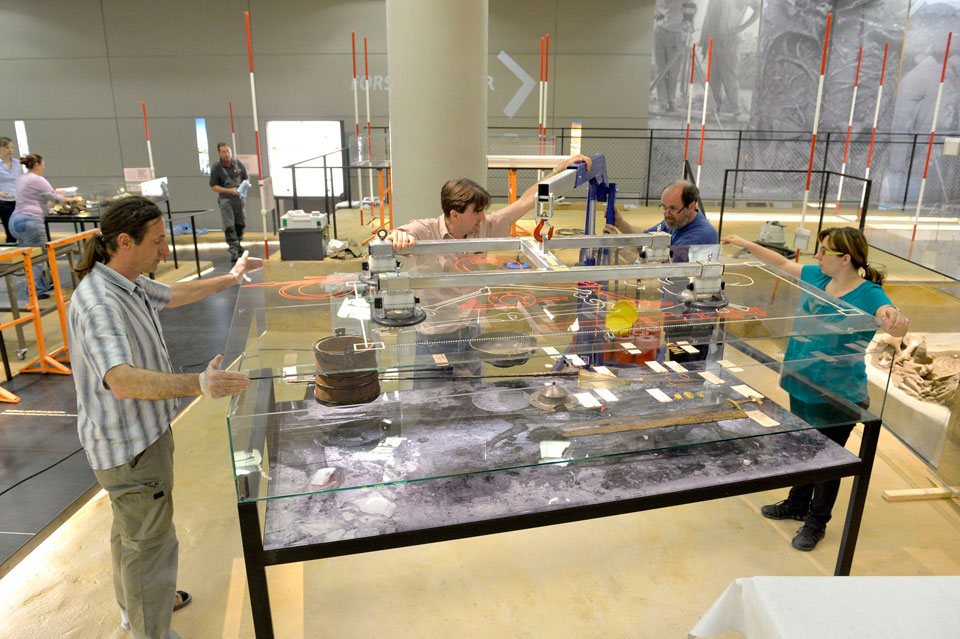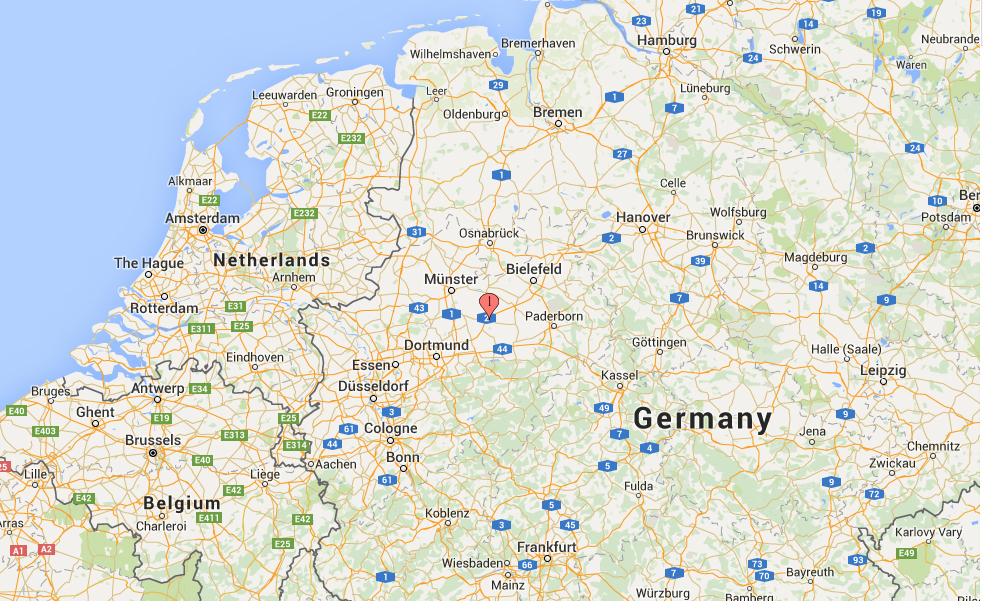The Prince from Beckum in North Rhein-Westphalia from the beginning of the 7th century tells a story of a man who lived in a mixed cultural setting.
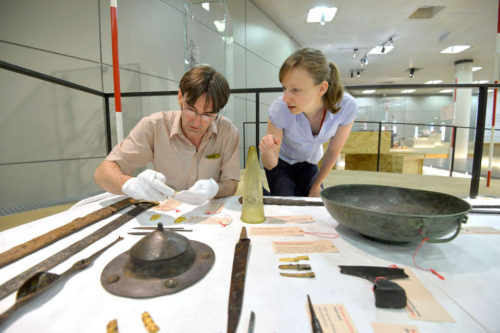
In 1959 Beckum – between Münster and Hannover – experienced an archaeological sensation, when the grave of a prince from the 7th century was discovered. The grave was soon identified as “Saxon”. Later interpretation has become much more careful designating the person in the grave as belonging to a specific tribe. However, the finds in the grave still command our attention.
The grave was found in a burial ground surrounded by a number of unfurnished graves as well as several graves with horses not far from the river Lippe south west of the centre of present Beckum.
Earlier excavations had yielded information about a series of graves (Beckum, phase I) which were located around another rich grave; perhaps holding a grandfather to the Prince of Beckum; perhaps they must be dated to around the same time. The prince from Beckum I was buried together with his horse. Surrounding the 57 other graves were the burials of fourteen horses. These graves were excavated 1860 – 63 in connection with work on a road; letters confirm that several other graves were not excavated, but just removed. Beckum I covers several phases, from AD 510 to 650. In the first phase males and females were buried separately. The grave goods can be dated to AD 510 – 65. In the next phase (Beckum, phase II) – dated between AD 565 – 600 – males and females were buried in between each other. Beckum, phase III – around 600 – is without female graves. Now, males accompanied by their weapons dominate. Several were fully furnished with sword, seax, lance and arrowheads. Finally, a few graves from 610 – 650 complete the finds from Beckum I.
Beckum II
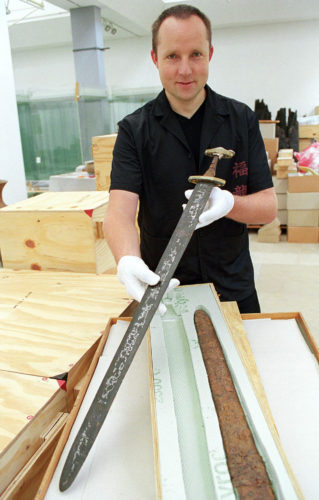
The new burial ground, which was discovered in 1959 lay 250 metres south-west of the first burial ground. Here 29 burials were found, one of which contained its own horse. To this should be added 22 graves with 33 horses. From the description of the excavation, it appears more graves might have been found had the area not been disturbed prior to this. In between the inhumations, a number of cremations were found.
In the northern part of the burial ground, a chamber-grave (2 x 3.2 m, 0.8 deep) was found, clad in stones and holding a square wooden coffin. In the grave, a 1.90 m long man was buried, laid to rest on his shield. He had died at the age of fifty. Later Strontium Analysis has identified the man as local chieftain – the so-called prince from Beckum – who was presumably buried in the same place as his ancestors and surrounded by his men and horses.
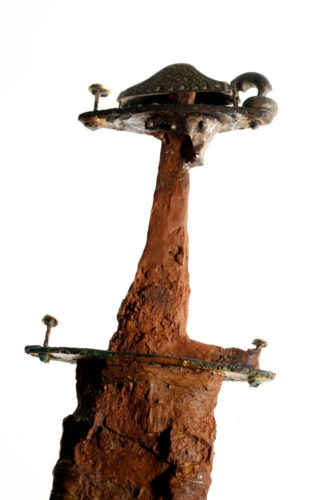
The latest grave goods have been dated to around 600, with some objects perhaps earlier (the glass beaker and the sword). The find consists of a full set of weapons: sword, seax, spear, lance, axe and shield. To this should be added a bronze basin, a bucket and a glass beaker. The damascene sword was fitted with a grip probably of narwhale ivory covered with a silver pommel with animal decoration. The knob was fitted with two interlaced rings of silver – a symbol of the ring-oath – signifying the status of the man as a military leader. The well-preserved scabbard of wood was lined with fur and covered in leather, girted with birch bast. In the bronze basin lay a comb. A purse, which had been fitted with three extraordinarily beautiful golden filigree covers, hung on his belt, which was fitted with a bronze buckle. In this was found two knives, tweezers, and a fire steel and stone. Near the head of the dead lay a golden solidus, a copy of a coin from the time of Justinian (527 – 565). On top of the casket was placed a wooden bowl decorated with golden strips decorated in animal style.
To the east and the south were twelve horses buried. In two of these grave rich harnesses were found which can be dated to app. the same time as the artefacts in the grave. Northeast of here were two graves with men buried with their arms; intriguingly, one of these men was buried on his stomach. Around his neck was found the remains of a leather cord fitted with two bronze rings. Archaeologists have speculated that the man was a burial gift in the same way as the horses. [1]
Who was he?
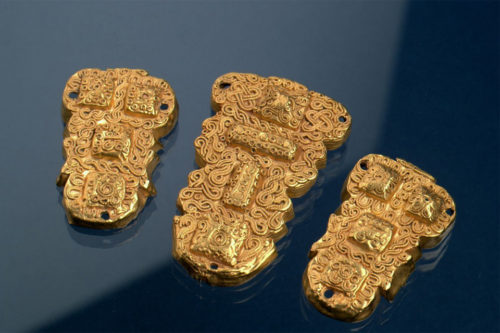
The graves at Beckum II can interestingly enough be dated to around 600, while Beckum I was still in use. Then – for some time – Beckum I was (again) preferred as the burial ground while Beckum II lay dormant. How long is not possible to determine precisely. This changed with the burial of the so-called prince of Beckum, who was found in the chamber grave, which unfortunately eludes a more precise dating; the spectrum of the grave goods is simply to varied but points to a period around AD 600.
The archaeologist, Vera Brieske, who has worked intensively over the so-far unpublished excavation reports, believe that the buried prince or chieftain from Beckum II was buried on the outskirts of the original burial ground, but in the same manner as the “first” prince of Beckum from Beckum I. Why further family members were not buried around the Beckum II man remains a puzzling question. She believes that the two men were closely affiliated due to the parallel way in which they were buried – in furnished graves fitted with full sets of weapons and with the exact same number of horses circling the two graves. Perhaps, father and child, we may ask?
“Because of the dates of the two rich graves surrounded by horses could be the father (death around 570) and son (death around 600). Unfortunately, the bones and teeth from the “father” have not been preserved so that DNA/DNS-Analysis is not possible”, she writes in a personal communique.
Frontier Zone
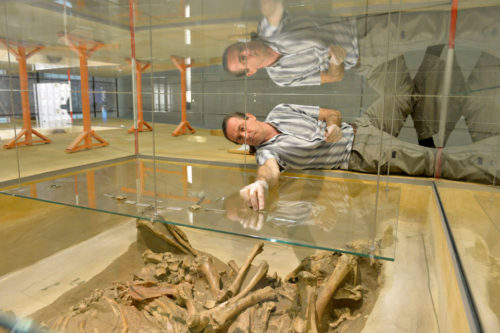
As to the grave goods from Beckum II, Vera Brieske writes that they look very much like other finds from the area around the lower Rhine and thus characterises them as “Merovingian” more than “Saxon”. On the other hand, the early to mid 7th century-date of the horse-burials in Beckum II is a token of the continued practise of a “Non-Christian” burial of the man at a time when the church was busy establishing itself to the east of the Rhine. But we don’t really know if the grave goods can signify anything except the geographical region, in which the people at Beckum moved around. For instance, the Frankish sword – which was definitely from an earlier period than the rest of the ensemble – might have been a gifted family treasure. But it might as well have been a piece of ancient war booty, which was placed in the grave signifying his defeat of Frankish enemies. It is likely the prince from Beckum died in battle as he was buried on his shield but no further osteological examination of his remains has been published.
Although it is probable that Germanic people in this period thought of themselves as belonging to ethnicities and tribes, it may no longer be possible to decide whether or not these men thought of themselves as either Frankish, Saxon, “Westfalaos” or even Thuringian. However, the prince from Beckum remains a fascinating example of a military leader endowed with at least one heirloom, a sword, signalling a connection with the Frankish world, but buried in a traditional pagan way in the locality, where he grew up, signifying a close connection between the man and the land in which he lived. This locality was in the region found on the right side of the Rhine (the ancient Limes) and bordering to what later became the heartland of Saxony to the North. It might thus be fruitful to think of him as the scion of a settlement located in a frontier zone and exhibiting a correspondingly mixed lifestyle.
Notes:
[1] It has been extensively argued by Judith Oexle that the Merovingian burials of horses (c. 500 – 700) should be seen as funeral gifts and not sacrifices. See: Merowingerzeitliche Pfedebestattungen – Opfer order Beigaben?. By Judit Oexle: In: Frühmittelalterliche Studien, 2010, Vol 18, pp. 122 – 172
Sources:
Reiche Aussteuer für die Unterwelt. Press release
Sächsisches Fürstengrab bei Beckum
Tradition and Akkulturation. Neue Untersuchungen zum “Fürsten” von Beckum.
By Vera Brieske
In: Das Miteinander, Nebeneinander und Gegeneindander von Kulturen. Zur Archäologie und Geschichte wechselseitiger Beziehungen im 1. Jahrtausend n. Chr. Ed. by Babette Ludowicki und Heike Pöppelmann s. 124 – 133
Sachse oder Franke? 50 Jahre Forschung zum Fürstengrab von Beckum
By Vera Brieske
In: Archäologie in Westfalen-Lippe 2009 (2010), pp. 189 – 192
Read more:
Archäologie des Frühen Mittelalters vom 5. bis zum 9. Jahrhundert in Westphalen – Ein Überblick. By Christoph Grünewald. In: Archäologie in Ostwestfalen, 2005, pp. 71 – 86. (with a slightly different understanding of the context of Beckum II)
A full presentation of the finds from Beckum is currently being prepared by Vera Brieske. Publication is planned for 2018.
READ ALSO:
SEE MORE
FEATURED PHOTO
Exhibiting the Prince from Beckum in Landesmuseum Westfalen © Landesmuseum Westfalen in Herne
